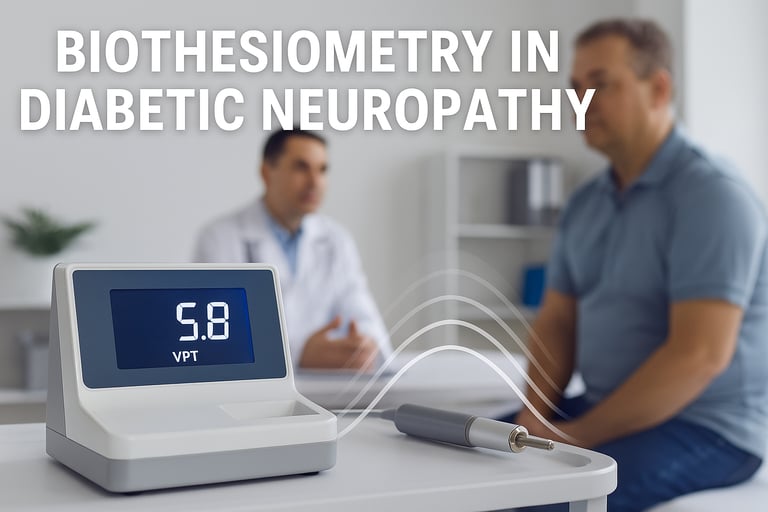Biothesiometry in Diabetic Neuropathy: A Quantitative Approach to Nerve Function Assessment
Diabetic neuropathy is one of the most common complications of diabetes, often leading to significant morbidity and the risk of foot ulcers. Accurate, early diagnosis is critical for effective management and prevention of further complications. Biothesiometry—a diagnostic tool that quantifies the vibration perception threshold (VPT)—has become indispensable in assessing nerve function in diabetic patients. This blog will explore how biothesiometry is utilized to detect diabetic neuropathy, its advantages, and its role in guiding clinical management.
Medtechoptions
4/5/20251 min read


What Is Biothesiometry?
Biothesiometry is a simple, non-invasive test that measures the vibration perception threshold. The procedure involves gradually increasing vibration intensity on specific points of the patient’s foot (or other areas) until the patient perceives the sensation. The minimal intensity detected is recorded as the VPT, providing an objective measurement of nerve sensitivity.
The Importance of VPT in Diabetic Neuropathy
Early Detection:
Subtle changes in nerve function often precede the clinical symptoms of diabetic neuropathy. Biothesiometry can detect these early changes, enabling prompt intervention.Objective Staging:
The numerical VPT values allow clinicians to quantify the severity of neuropathy. This helps in staging the disease and monitoring its progression over time.Preventive Care:
Identifying patients with elevated VPT values can prompt early therapeutic measures, potentially reducing the risk of foot ulcers, infections, and subsequent amputations.Cost-Effective & Patient-Friendly:
The test is quick, non-invasive, and inexpensive, making it suitable for routine screening in diabetic clinics.
Clinical Impact
Multiple studies have demonstrated a significant correlation between elevated VPT values and the degree of diabetic neuropathy. This quantitative approach not only aids in early diagnosis but also provides a basis for evaluating the effectiveness of interventions aimed at restoring nerve function.
Conclusion
Biothesiometry represents a breakthrough in the early detection and management of diabetic neuropathy. By providing an objective, quantitative measure of nerve function, it facilitates early diagnosis and ongoing monitoring of diabetic patients. As clinicians increasingly rely on this tool, biothesiometry is set to play a pivotal role in preventing the serious complications associated with diabetic neuropathy.
References
Johnson, M., et al. (2017). The Role of Vibration Perception Threshold in the Early Diagnosis of Diabetic Neuropathy. Diabetes Care Journal.
Kumar, S., & Gupta, P. (2020). Quantitative Assessment of Nerve Function in Diabetic Patients Using Biothesiometry. Journal of Diabetes and Its Complications.
